Introduction
- Three layers of organizational culture.
- Organizational culture in health care.
- Nurses’ views on organizational culture.
Organizational culture is a complex concept, and several definitions exist. One of the most common descriptions of the term was provided by Schein (Willis et al., 2016). According to Schein’s perspective, organizational culture includes three layers: artifacts, values, and basic assumptions. Artifacts are documents and tangible items reflecting or regulating the relationships in the organization. The second layer is manifested in values, norms, and rules. The deepest layer is the basic assumptions defining people’s behavior. Irrespective of the industry, organizational culture shapes the way companies develop. In health care, a strong organizational culture is a background for the provision of high-quality services to patients (Wick et al., 2015). Nursing practitioners acknowledge the importance of the development or maintenance of a strong organizational culture. However, nurses are often reluctant to be involved in the process of the development or change of the culture.
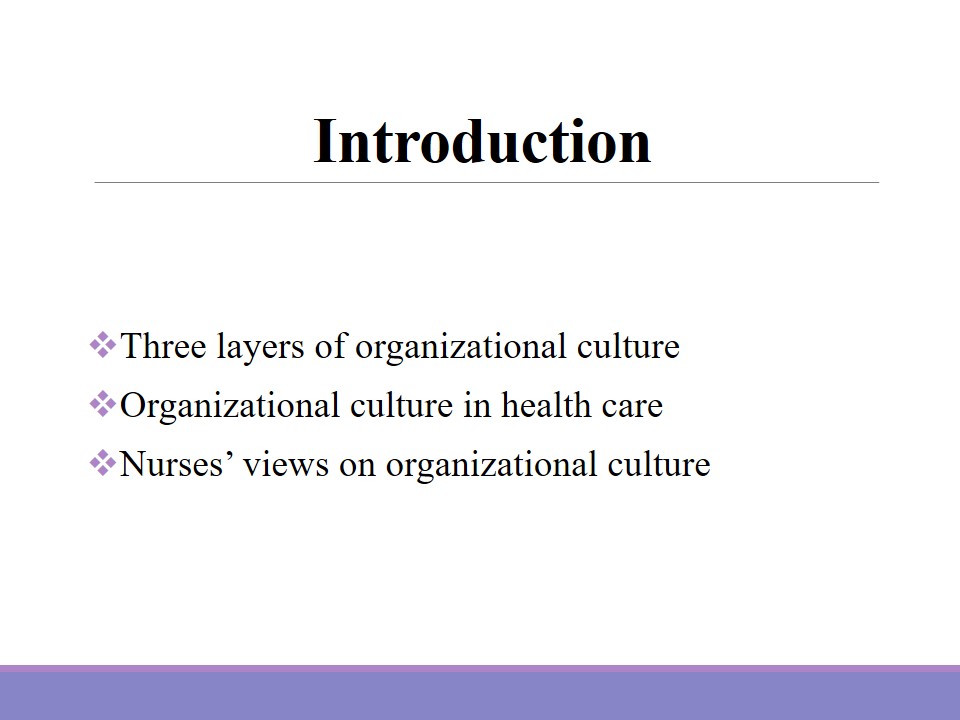
Mission, Vision, and Values
- Vision as the ultimate goal to attain.
- Mission as a strategy to achieve the established goals.
- Values as the code of conduct.
Organizational culture can be outlined briefly with the help of such concepts as vision, mission, and values. Every institution or company provide this information on their websites, which helps people (and potential partners) to have a quick overview of the organization (Willis et al., 2016). The purpose of the vision is to identify the primary goals of the company in terms of their general input and role in the society. The mission is a very short description of the methods the organization intends to use to attain the goal. Values are the principles guiding employees’ behavior, a code of conduct, to a certain extent.
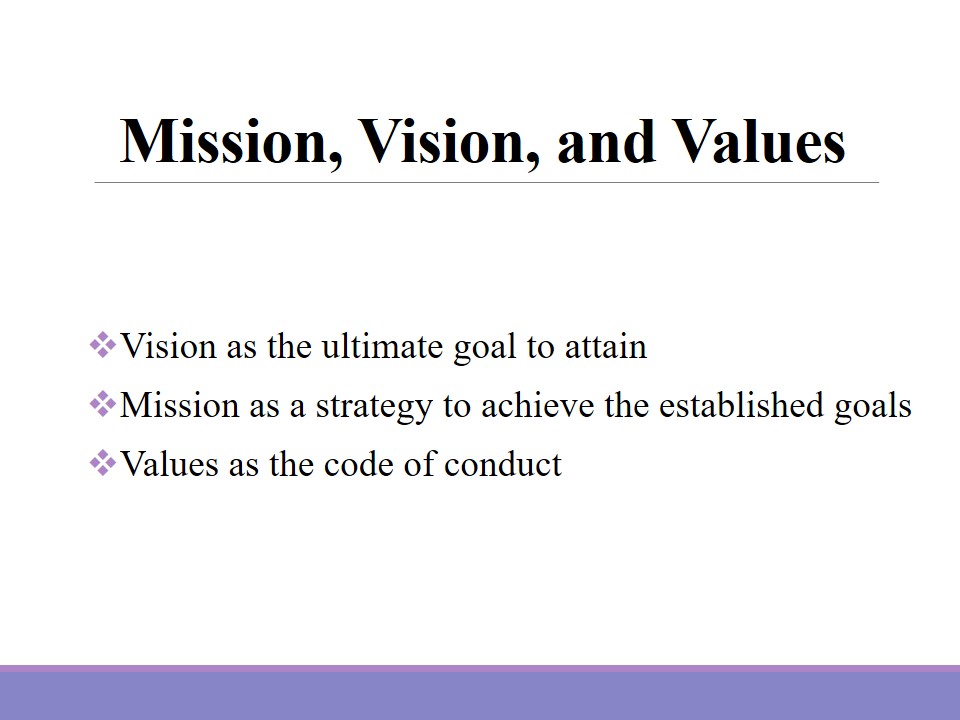
Mission, Vision, and Values and Nurse Engagement
Nurse engagement can be achieved and / or enhanced by
- Effective recruiting.
- Clear identification of the mission, vision, and values.
- Modification of the mission, vision, and values.
It has been found that the organizational culture, including its specific components such as mission, vision, and values, has a considerable effect on nurse engagement (Willis et al., 2016; Körner, Wirtz, Bengel, & Göritz, 2015). Organizations with a strong culture perform better since employees tend to share certain values and focus on clear goals. In order to ensure nurse engagement, it is essential to implement effective recruiting practices and employ people who share certain values and adhere to specific standards. It is also critical to make sure that the mission, vision, and values are clear. Companies constantly evolve, and it is important to introduce some modifications to the mission, vision, or values if necessary. Nursing professionals are willing to comply with regulations that are consistent with the most urgent needs of the company.
The staff should be properly trained and empowered to feel engaged (Willis et al., 2016). Nurses may need specific skills or knowledge to adhere to the standards and values existing in an organization. They should also have the skills to perform tasks necessary to achieve the established goals (vision) using the methods and channels described in the organization’s mission. Effective leadership is another vital factor affecting nurse engagement (Almost et al., 2016). Leaders refer to the values and make sure that nursing professionals are committed to the established mission and vision. This approach ensures nurse engagement and the high performance of the entire medical staff.
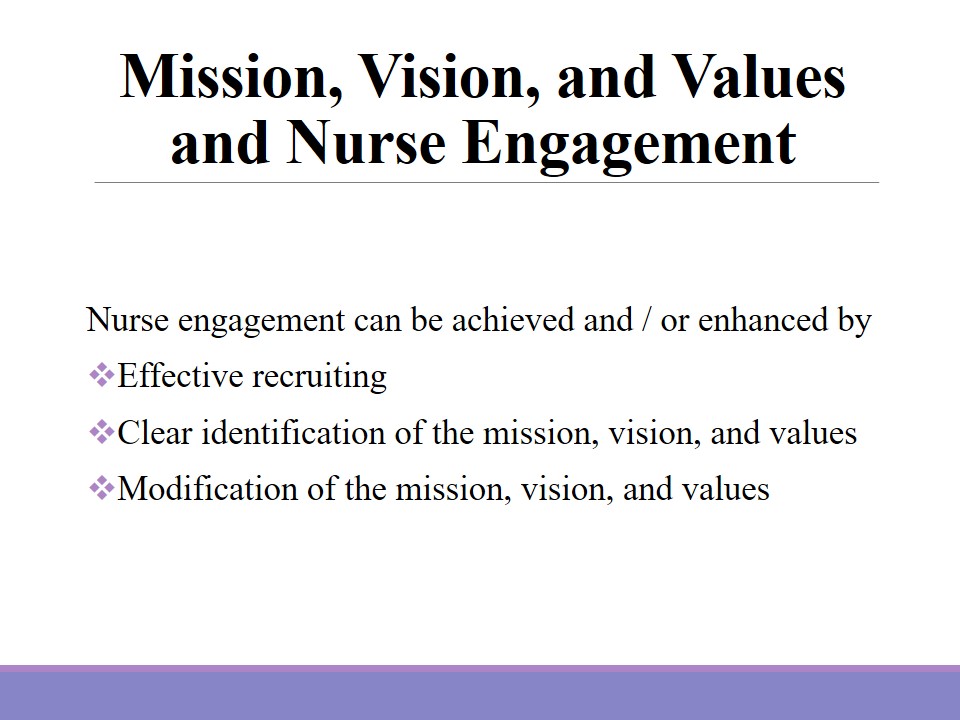
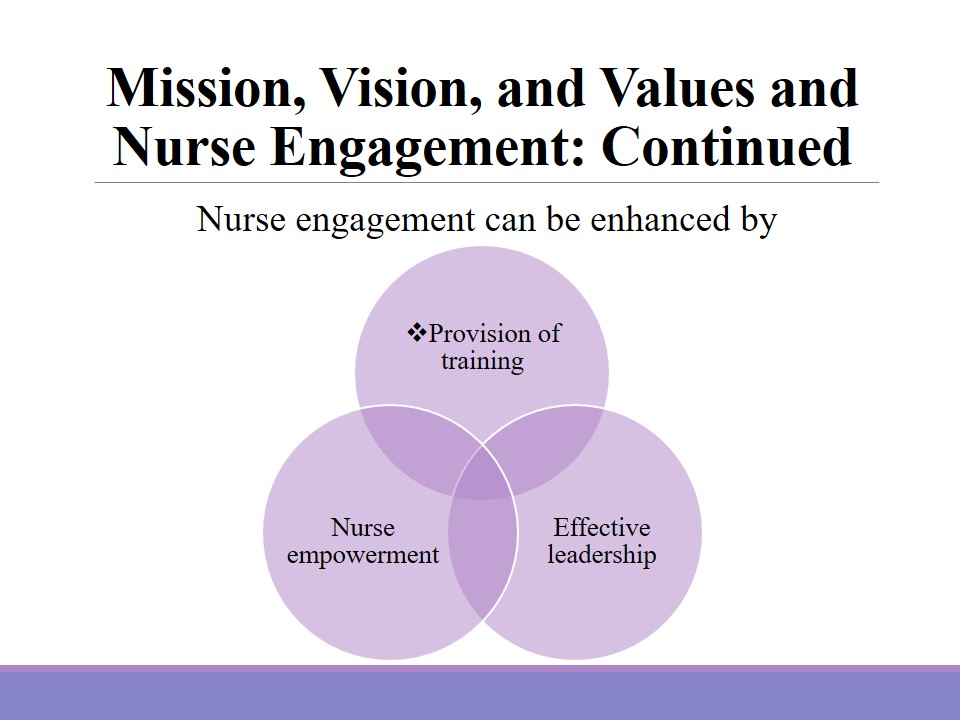
Mission, Vision, Values and Patient Outcomes
- Clear goals and well-designed practices and standards.
- Effective cross-functional teams.
- Staff’s high performance.
- Controlled workload and decreased number of medical errors.
- Effective nurse-patient communication.
- Staff’s high morale and low fatigue and dissatisfaction.
As mentioned above, a clear mission, vision, and values are instrumental in improving nurses’ engagement and performance. Medical staff is better equipped with knowledge, and employees adhere to effective standards and norms that contribute to the provision of high-quality care (Willis et al., 2016). Although medical errors are unlikely to be eliminated completely, strong organizational culture with proper mission and values is associated with a decreased number of undesirable situations. Therefore, patient outcomes positively correlate with the establishment of clear and well-thought vision, mission, and values.
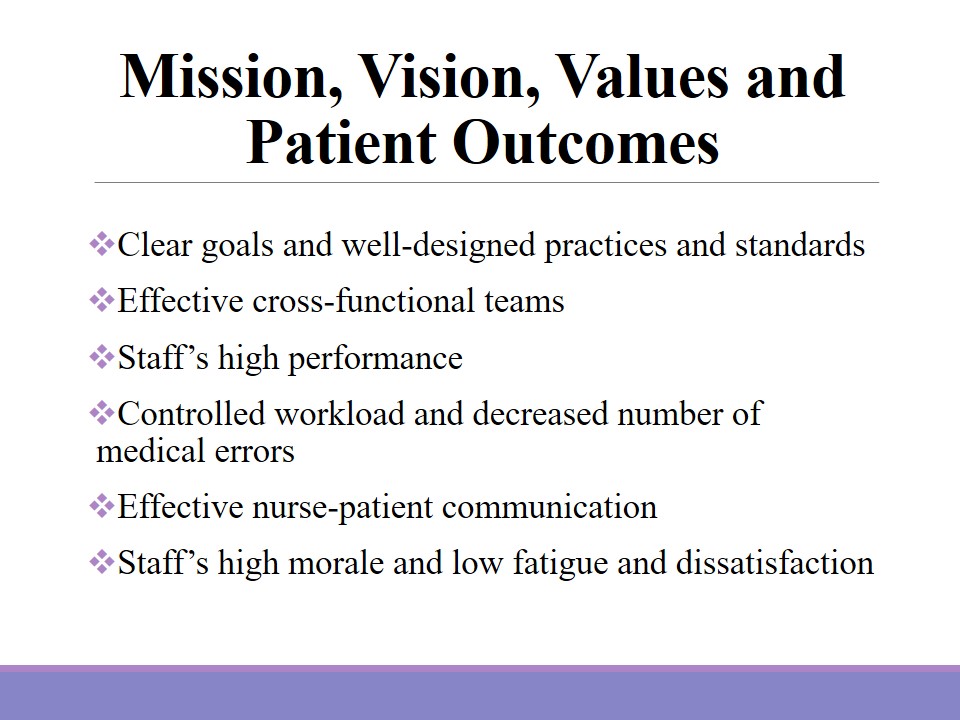
Factors Leading to Conflicts in a Professional Practice
Conflicts are an indispensable part of people’s lives, and the professional area can be no exception. Diversity is one of the pillars of development, but it is often a source of conflict. People’s personal traits account for many conflicting situations because individuals have different personalities, backgrounds, and interests (Willis et al., 2016). Insufficient resources and improperly defined roles lead to misunderstandings and conflict as well (Almost et al., 2016). Employees may lack the skills to perform tasks, which leads to overlaps and overload. Ineffective communication channels also contribute to the development of conflicts because people do not have sufficient data to make proper well-informed decisions.
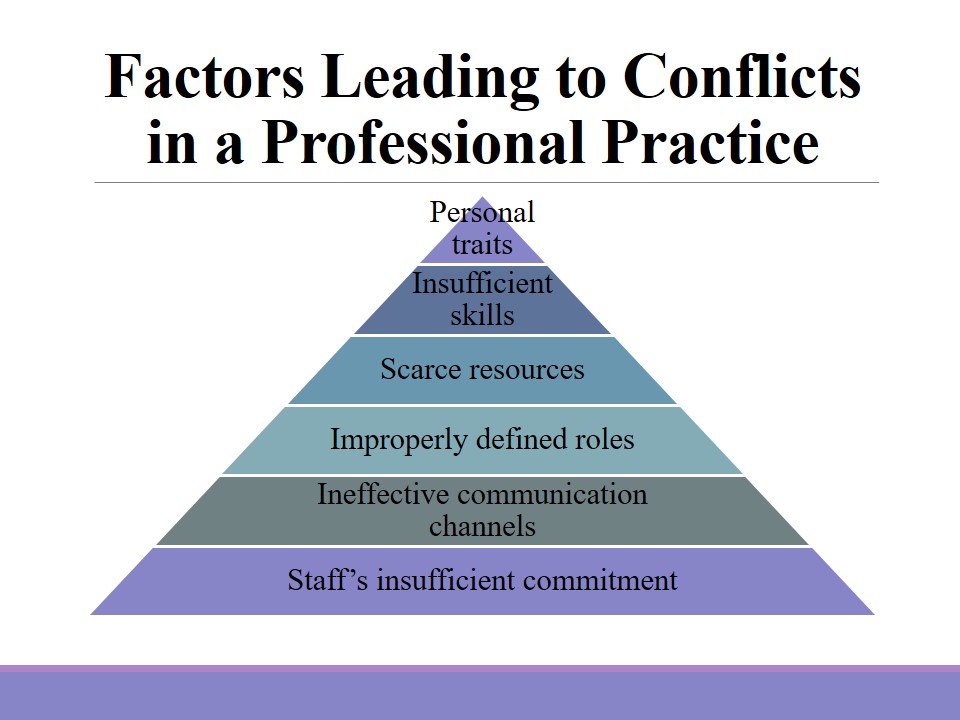
Conflict in a Professional Practice and Organizational Culture
- The lack of clearly defined mission, vision, and values.
- Ineffective implementation of the organizational culture.
- Weak leadership.
Poor organizational culture is another reason for conflicts since people do not share similar values and use different methods to achieve the established goals (Almost et al., 2016). If an organization does not have a well-defined mission, vision, and values, employees behave in accordance with their previous work experience or their personal traits. It is also important to make sure that the organizational culture is properly implemented and the staff’s appropriate conduct is rewarded while low adherence to the existing norms is punished. Effective leaders are central figures to the maintenance of a strong organizational culture and employees’ excellent performance.
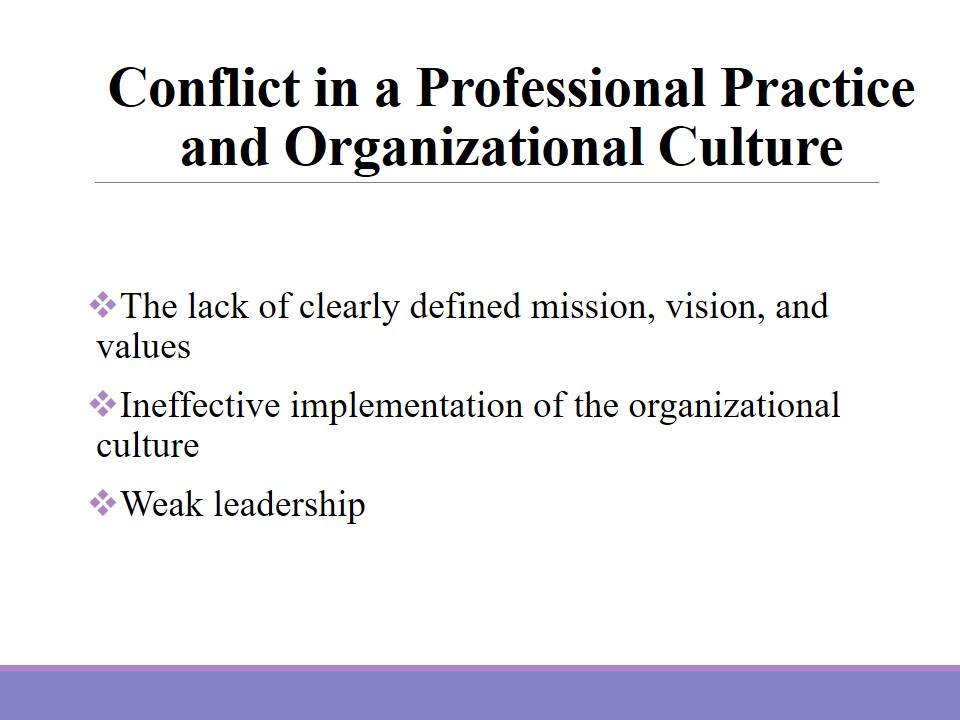
Organizational Culture and the Way Conflict Is Addressed
Strong organizational culture is associated with
- effective communication channels.
- prompt identification of conflicts.
- clearly defined practices to mitigate conflict.
Organizations with strong cultures tend to have effective strategies to address conflict. Apart from a properly described mission, vision, and values, such organizations have effective communication channels, which is instrumental in mitigating conflict (Wick et al., 2015). The identification of conflict situations and the reasons behind them is facilitated by the existence of effective norms and guidelines. The standards aimed at addressing conflicts are also described with the help of standards and values.
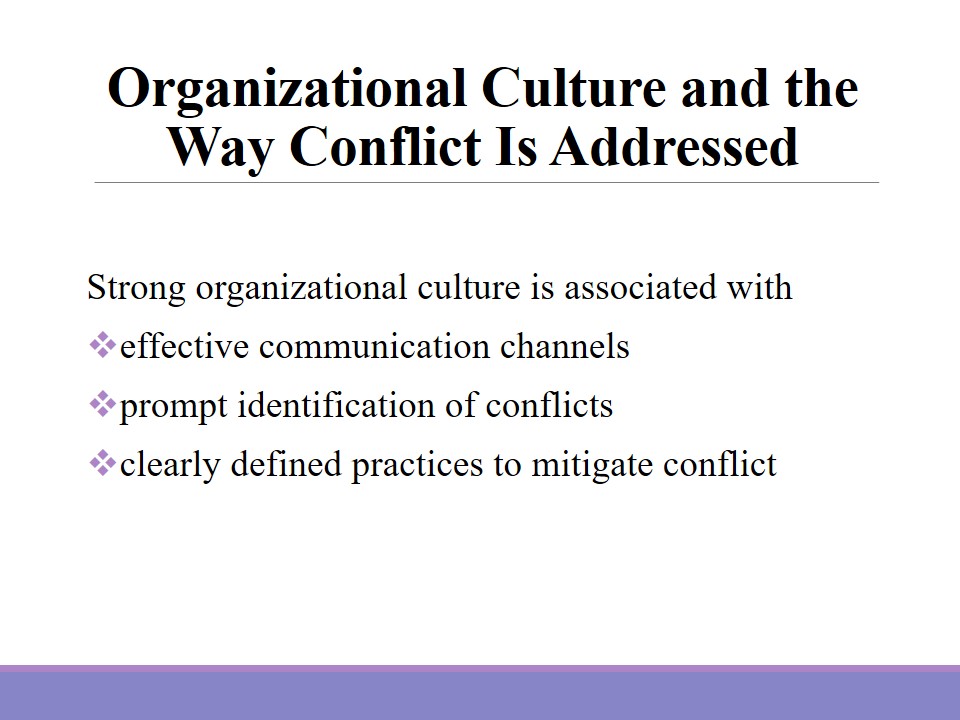
Effective Strategies to Resolve Workplace Conflict
Almost et al. (2016) note that the research regarding effective strategies to address conflict in the healthcare setting is insufficient. Nevertheless, certain advances have been described and can be utilized by practitioners. As mentioned above, organizations should have specific guidelines and norms employees can use in diverse situations. Transformational leadership is one of the most potent tools to mitigate and avoid workplace conflict, as well as facilitate interprofessional collaboration. It is also necessary to provide training aimed at addressing the existing gaps, especially when it comes to such areas as communication, time and conflict management, emotional intelligence. Self-reflection has proved to be an efficient strategy that equips practitioners with the understanding of their traits and values, as well as ways to ensure their adherence to organizational culture.
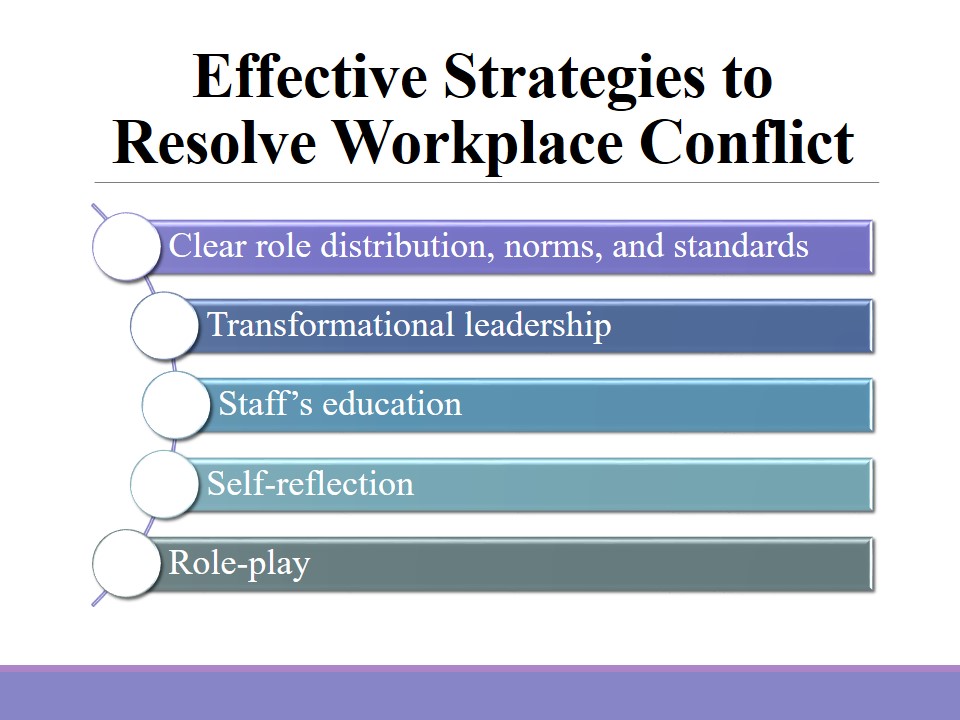
Organizational Needs/Health Care Culture & Organizational Outcomes
Positive outcomes if
- organizational needs are consistent with organizational culture.
- organizations operate in terms of the culture of health care.
Negative outcomes if
- there is no strong culture of health care in the community.
- the organization focuses on specific outcomes (financial) and ignores others.
Organizational outcomes include facilities’ overall performance, financial gains or losses, return on assets, turnover, human capital, among others. When organizations’ needs are consistent with their mission, vision, and values, they achieve positive outcomes. The prevalence of the culture of health care in the community can also have a favorable effect on healthcare facilities’ outcomes as people and organizations will share certain values and goals. The lack of such culture may lead to poor communication and collaboration in the relationships between healthcare professionals and the community (patients, policymakers, the public). When healthcare organizations try to achieve certain outcomes (usually financial) at the expense of other areas, these facilities may experience low performance, high turnover, patient dissatisfaction, and other issues.

Needs / Health Care Culture as Related to Health Promotion and Disease Prevention
- High standards and sustainable organizational needs.
- Effective communication and collaboration with the public.
- Prevention and wellness as the major goal.
Healthcare organizations, as well as companies operating in any industry, can have a positive influence on health promotion. The primary premise for this favorable impact is the establishment of high standards and the focus on sustainable organizational needs. Companies should concentrate on such outcomes as the provision of high-quality care, high retention, and job satisfaction, which inevitably leads to financial and reputational gains. Organizations need to facilitate effective collaboration with the community, which will create trustful relationships. Prevention and wellness should be the major goals for organizations that should promote prevention. These efforts will make people more responsible and willing to follow recommendations, which will eventually result in positive changes from a community health perspective.

Conclusion
Strong organizational culture is the basis for
- vpositive organizational outcomes.
- veffective interprofessional collaboration.
- vexcellent performance.
- vestablishment of the culture of health care in the community.
- vthe focus on disease prevention and wellness in the community.
This brief analysis of the value of the organizational culture shows that it is instrumental in achieving high organizational outcomes. Companies can become leaders in their industry and set new standards in health care. Clearly, a lot of effort is necessary to ensure the maintenance of effective organizational culture, and even more energy should be invested to facilitate the change in the community.
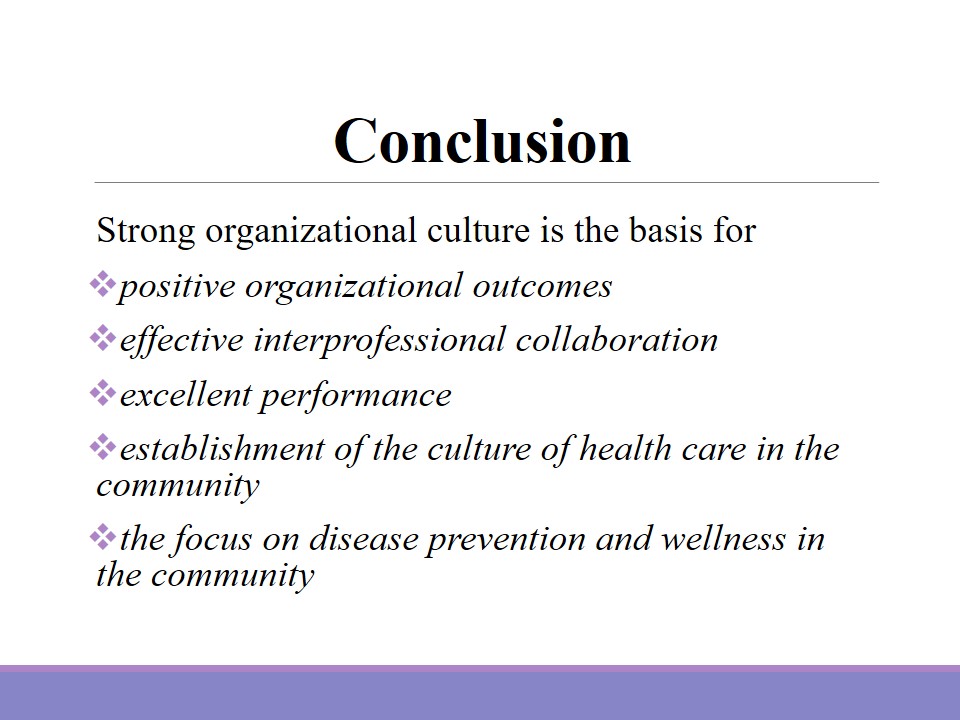
References
Almost, J., Wolff, A. C., Stewart-Pyne, A., McCormick, L. G., Strachan, D., & D’Souza, C. (2016). Managing and mitigating conflict in healthcare teams: An integrative review. Journal of Advanced Nursing, 72(7), 1490-1505. Web.
Körner, M., Wirtz, M. A., Bengel, J., & Göritz, A. S. (2015). Relationship of organizational culture, teamwork and job satisfaction in interprofessional teams. BMC Health Services Research, 15(1). Web.
Wick, E. C., Galante, D. J., Hobson, D. B., Benson, A. R., Lee, K. H. K., Berenholtz, S. M., … Wu, C. L. (2015). Organizational culture changes result in improvement in patient-centered outcomes: Implementation of an integrated recovery pathway for surgical patients. Journal of the American College of Surgeons, 221(3), 669-677. Web.
Willis, C., Saul, J., Bevan, H., Scheirer, M., Best, A., Greenhalgh, T., … Bitz, J. (2016). Sustaining organizational culture change in health systems. Journal of Health Organization and Management, 30(1), 2-30. Web.